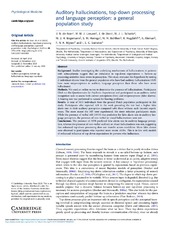| dc.contributor.author | de Boer, Janna N. | |
| dc.contributor.author | Linszen, Mascha M.J. | |
| dc.contributor.author | de Vries, J. Hans | |
| dc.contributor.author | Schutte, Maya J.L. | |
| dc.contributor.author | Begemann, Marieke J.H. | |
| dc.contributor.author | Heringa, Sophie M. | |
| dc.contributor.author | Bohlken, Marc Marijn | |
| dc.contributor.author | Hugdahl, Kenneth | |
| dc.contributor.author | Aleman, André | |
| dc.contributor.author | Wijnen, Frank N.K. | |
| dc.contributor.author | Sommer, Iris Else Clara | |
| dc.date.accessioned | 2020-06-24T08:37:27Z | |
| dc.date.available | 2020-06-24T08:37:27Z | |
| dc.date.issued | 2019 | |
| dc.Published | de Boer, Linszen MM, de Vries, Schutte MJ, Begemann MJ, Heringa SM, Bohlken, Hugdahl K, Aleman A, Wijnen, Sommer IEC. Auditory hallucinations, top-down processing and language perception: a general population study. Psychological Medicine. 2019;49(16):2772-2780 | eng |
| dc.identifier.issn | 0033-2917 | |
| dc.identifier.issn | 1469-8978 | |
| dc.identifier.uri | https://hdl.handle.net/1956/22908 | |
| dc.description.abstract | Background: Studies investigating the underlying mechanisms of hallucinations in patients with schizophrenia suggest that an imbalance in top-down expectations v. bottom-up processing underlies these errors in perception. This study evaluates this hypothesis by testing if individuals drawn from the general population who have had auditory hallucinations (AH) have more misperceptions in auditory language perception than those who have never hallucinated. Methods: We used an online survey to determine the presence of hallucinations. Participants filled out the Questionnaire for Psychotic Experiences and participated in an auditory verbal recognition task to assess both correct perceptions (hits) and misperceptions (false alarms). A hearing test was performed to screen for hearing problems. Results: A total of 5115 individuals from the general Dutch population participated in this study. Participants who reported AH in the week preceding the test had a higher false alarm rate in their auditory perception compared with those without such (recent) experiences. The more recent the AH were experienced, the more mistakes participants made. While the presence of verbal AH (AVH) was predictive for false alarm rate in auditory language perception, the presence of non-verbal or visual hallucinations were not. Conclusions: The presence of AVH predicted false alarm rate in auditory language perception, whereas the presence of non-verbal auditory or visual hallucinations was not, suggesting that enhanced top-down processing does not transfer across modalities. More false alarms were observed in participants who reported more recent AVHs. This is in line with models of enhanced influence of top-down expectations in persons who hallucinate. | en_US |
| dc.language.iso | eng | eng |
| dc.publisher | Oxford University Press | eng |
| dc.rights | Attribution CC BY | eng |
| dc.rights.uri | http://creativecommons.org/licenses/by/4.0 | eng |
| dc.title | Auditory hallucinations, top-down processing and language perception: a general population study | eng |
| dc.type | Peer reviewed | |
| dc.type | Journal article | |
| dc.date.updated | 2020-02-14T15:26:13Z | |
| dc.description.version | publishedVersion | |
| dc.rights.holder | Copyright Cambridge University Press 2019 | eng |
| dc.identifier.doi | https://doi.org/10.1017/s003329171800380x | |
| dc.identifier.cristin | 1791303 | |
| dc.source.journal | Psychological Medicine | |

